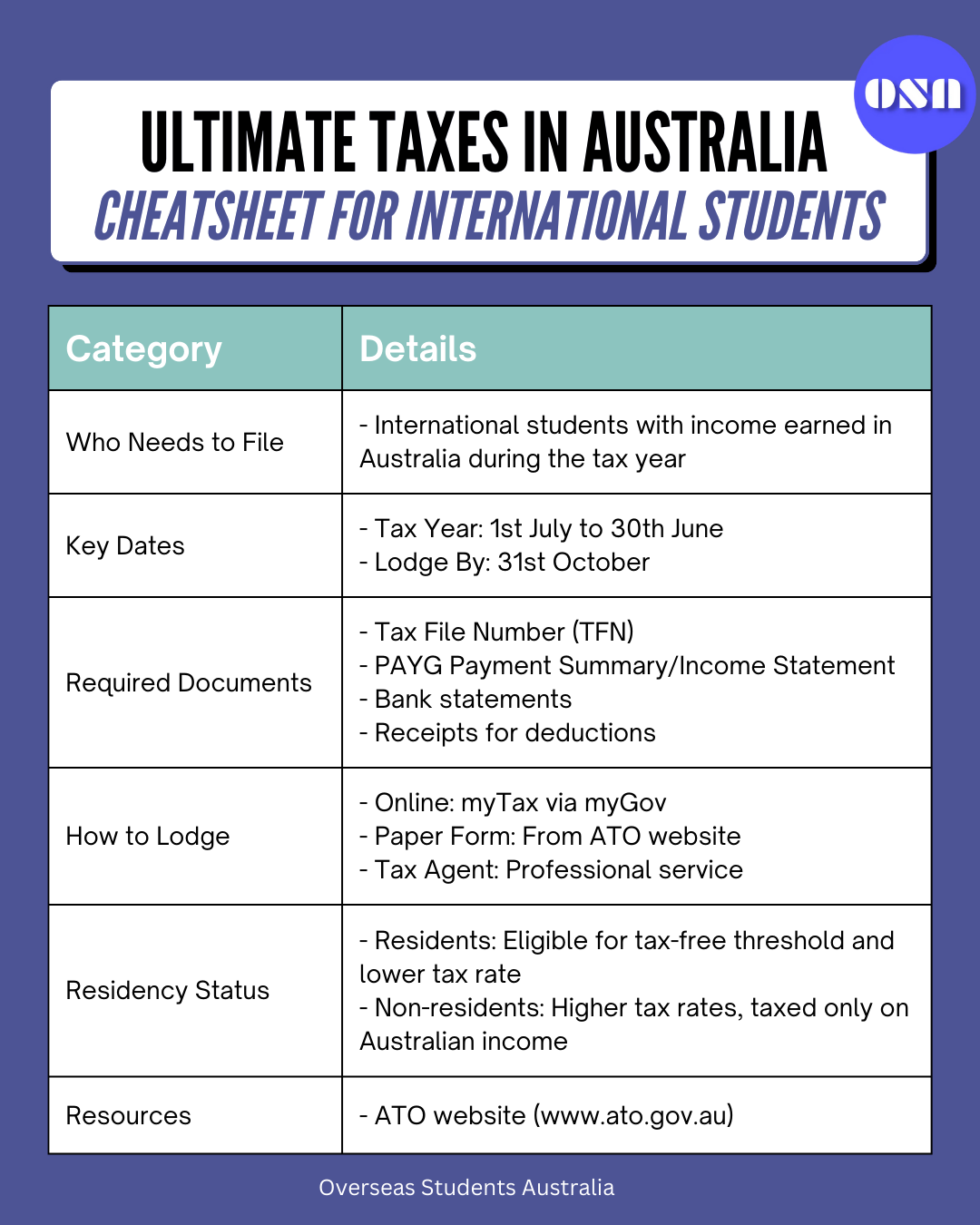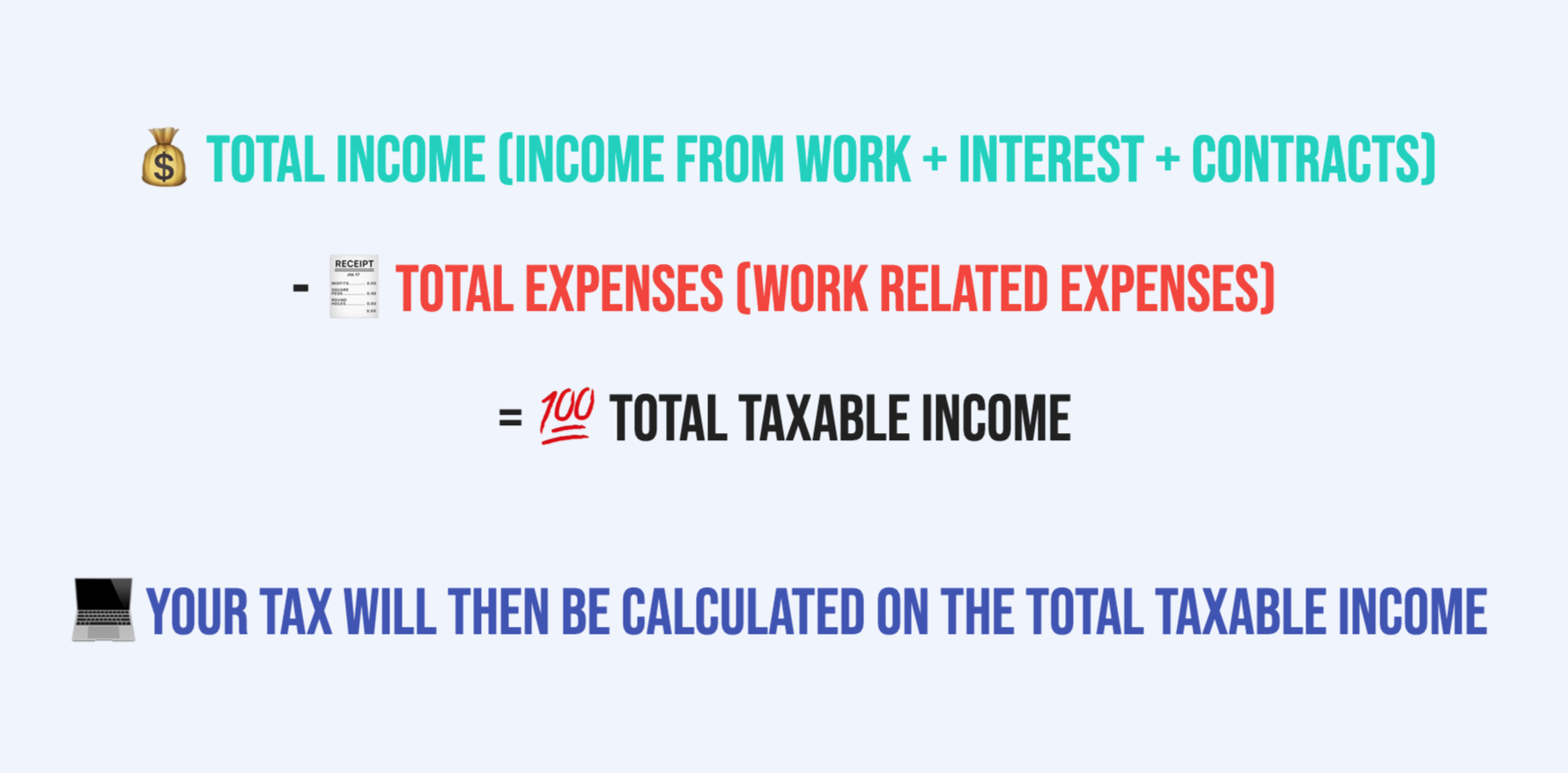The Ultimate Guide to Tax Returns for International Students in Australia


An International Student’s life in Australia is not a walk in the park.
As students have to juggle between their study, work and other aspects of life by themselves.
And add taxes on top of that, makes things very interesting to say the least.
So, we are here to make one aspect of life easier by giving the ultimate guide to tax returns for international students in Australia.
Let’s get started.
Important Disclaimer: This information is general in nature and does not constitute any financial advice. If you have specific questions about your tax return, we highly recommend seeking help from a registered taxation agent.
⏱️ What are some basics of Taxes in Australia?
Before we get started, it is important to understand some basic acronyms related to taxes in Australia.
ATO – AustralianTaxation Office
TFN – Tax File Number
ABN – Australian Business Number
BAS – Business Activity Statement
GST – Goods and Services Tax
PAYG – Pay As You Go
Want to know more acronyms that are commonly used in Australia? Check our article here.
It is also very important to know that Australia’s financial year starts on 1st July and ends on 30th June each year.
After 30th June, individuals and businesses need to file their tax returns reporting their income and deductions.
The last day of filing your own taxes is 31st October. However, if you are filing your taxes with a registered taxation agent, then you can file it until 15th May next year.
Here is a quick cheatsheet for the basics of taxes in Australia:

💸 What is a difference between working on TFN vs ABN for tax purposes?
If you are going to work in Australia, chances are that you will be using either TFN (Tax File Number) or ABN (Australian Business Number) or both.
The arrangements for working on ABN and TFN are quite different, and their tax implications are different as well.
Here are some differences for tax purposes between Working on TFN vs ABN:
| TFN | ABN |
| You work as an employee | You work as a business or contractor or partner |
| Your income is considered as an employment income. | Your income is considered as business income |
| You get a payslip | You issue an invoice |
| Your employer will withhold taxes from your salary | You need to manage your own taxes with applicable BAS, PAYG and GST arrangements |
If you want to know other differences between ABN and TFN, then check this article.
What is the difference between Resident vs Non-Resident for Tax Purposes?
It is also critical to understand your residency status in Australia.
As the amount of taxes you pay will on your income will depend on whether you are considered as a resident or non-resident in Australia.
In short, as a non-resident for tax purposes in Australia, you pay higher taxes.
To be a resident for tax purposes, you must have lived or intend to live in Australia for at least 6 months continuously or met the requirements mentioned below.
🧑🎓 Are international students considered foreign or Australian residents for tax purposes?
Luckily, if you are an international student who has come to study in Australia for a course longer than 6 months, then you are considered as a resident for tax purposes.
It means you are paying the same amount of taxes as local Australians. Also, you get benefits of claiming tax-free thresholds, tax offsets and lower tax rates.
However, if your course is shorter than 6 months, and you intend to leave before 6 months, then you will be considered as a non-resident. It means you will be higher amount of taxes in that case.
You can check the difference between the taxes that residents and non-residents have to pay in Australia in the tax tables below.
That’s why it is important to complete your tax withholding form correctly when you get a new job in Australia. You can check this video here for details to avoid mistakes when filling out the TFN Witholding form here.
You can check details about residency status on the ATO’s website.
You can check more details on international students on the ATO’s website.
🤑 Do I need to report my income from my home country?
As an international student in Australia, you are regarded as a temporary resident, so you don’t need to report most of your income you earn overseas, and you will not be taxed on it.
You will only need to report any income you earn in Australia plus any income you earn from employment performed overseas for short periods while you are a temporary resident of Australia.
💻 Do I need to lodge a tax return?
There are 3 most common scenarios for answering this question:
1️⃣ You must lodge a tax return if you have worked a part-time job in Australia and you have earned more than the tax-free threshold ($18,200) during the financial year.
2️⃣ If you haven’t earned more than the tax-free threshold but paid some taxes, then you should lodge a tax return for getting a refund for the taxes paid.
3️⃣ If you haven’t earned more than the tax-free threshold, and you didn’t pay any taxes, you may not need to lodge a tax return but you may still need to advise ATO (Australian Taxation Office) about the non-lodgment.
It is lodged to let the ATO know that you don’t need to lodge the tax return for this year. You will need to complete non-lodgment advice which can be done online through a myGov account.
You can also check a tool on ATO’s website for finding out if you need to lodge a tax return or not.
📅 What is the last date to lodge a tax return in Australia?
The last date of lodging the tax return in Australia is 31st October.
If you are doing your own tax return, you will need to complete and lodge it any time between 1st July to 31st October.
However, registered tax agents have a special lodgment program and can lodge the tax return even after the 31st October deadline as well.
📃 What do I need to file my tax return?
In order to lodge your tax return to Australia as an international student, you will need few things:
✅ TFN – You need to have your tax file number to file your taxes.
✅ ABN – If you worked as a contractor, then you need an Australian Business Number.
✅ Payment Summaries – These summaries are usually issued by your employer at the end of the financial year for all the income you earned and taxes withheld from it. These days you may not get these summaries as employers provide the information directly to ATO. So when you lodge your own taxes or with a tax agent, then it appears automatically in the income section.
✅ Invoices – If you issued any invoices for your business, then you need to have them ready.
✅ Receipts, Invoices – If you have any work-related expenses that you are going to claim in your tax return, you will need them.
✅ Photo ID – If you’re getting taxes done from an accountant, you will also need to bring some sort of ID like your passport or your driving license.
💵 What types of income are included in my tax return?
It is important that you report any taxable income that you earn during the financial year in your tax return. Some of the common types of income that international students report might include (but are not limited to):
👉 Wages and salaries from part-time jobs
👉 Income earned as a contractor
👉 Business income
👉 Bonus or commission earned
👉 Government payments / allowances
👉 Non-government scholarships, grants or awards
👉 Bank Interest
👉 Other investment incomes like shares, cryptocurrencies etc.
🧾 What type of expenses can I claim as a deduction?
You can claim your work-related expenses as a deduction in your tax return. Here are some examples of expenses that you might be able to claim in your taxes (but not limited to):
👉 Uniform and laundry expenses
👉 Travel between the jobs (not including commute from home)
👉 Work-related phone and internet expenses
👉 Home office expenses
👉 Cost of managing tax affairs (eg. tax accountant fee)
👉 Union fees
👉 Charitable donations
It is very important that you keep records like receipts, invoices etc. of all the expenses you make during the year. If you don’t keep the appropriate records to substantiate your claims, then you can face penalties if you get audited by the taxation office.
🩺 Do I need to pay a Medicare levy?
The Medicare levy helps fund some of the costs of Australia’s public health system known as Medicare. The Medicare levy is 2% of your taxable income, in addition to the tax you pay on your taxable income.
As an international student, you don’t need to pay a Medicare levy as you are not entitled to Medicare benefits in Australia.
To get an exemption from paying Medicare levy, you will need to apply for a Medicare Entitlement Statement from Services Australia here. This statement will tell you the period you were ineligible for Medicare.
It can take a few weeks to get this statement, so we suggest you apply for this nice and early.

🤔 How are the taxes calculated?
Your income tax you need to pay will be based on how much income you earn in a financial year.
Australia uses a progressive tax system, which means the more you earn, the more taxes you pay.
In order to calculate your taxes, you need to use a very simple formula:
Income from all sources (like salary, business, interest, investments)
Minus work deduction (like work related expenses for car, mobile, uniform, home office etc.)
Equal to taxable income
Income – deductions = taxable income

Based on your taxable income, you might be liable for medical levy (which is 2% of taxable income).
As many international students are not entitled to medicare in Australia, they don’t have to pay the medicare levy.
But they need to apply for a Medicare levy exemption certificate from Services Australia before filing their tax returns.You can apply for it from here.
As mentioned earlier, Australia uses a progressive taxation system, which means higher income earners get taxed at higher rates.
Check the tax table below to see how much tax residents have to pay in Australia based on their income.
Resident Tax Table 2024-25
| Taxable Income | Tax On This Income |
| 0 to $18,200 | Nil |
| $18,201 to $45,000 | 16c for each $1 over $18,200 |
| $45,001 to $135,000 | $4,288 plus 30c for each $1 over $45,000 |
| $135,001 to $190,000 | $31,288 plus 37c for each $1 over $120,000 |
| $190,001 and over | $51,638 plus 45c for each $1 over $190,000 |
Resident Tax Table 2023-24
| Taxable Income | Tax On This Income |
| 0 to $18,200 | Nil |
| $18,201 to $45,000 | 19c for each $1 over $18,200 |
| $45,001 to $120,000 | $5,092 plus 32.5c for each $1 over $45,000 |
| $120,001 to $180,000 | $29,467 plus 37c for each $1 over $120,000 |
| $180,001 and over | $ 51,667 plus 45c for each $1 over $180,000 |
Non-Resident Tax Table 2024-25
| Taxable income | Tax on this income |
| $0 – $135,000 | 30c for each $1 |
| $135,001 – $190,000 | $40,500 + 37c for each $1 over $120,000 |
| $190,001 and over | $60,850 + 45c for each $1 over $190,000 |
Non-Resident Tax Table 2023-24
| Taxable income | Tax on this income |
| $0 – $120,000 | 32.5c for each $1 |
| $120,001 – $180,000 | $39,000 + 37c for each $1 over $120,000 |
| $180,001 and over | $61,200 + 45c for each $1 over $180,000 |
You can check all the current and previous tax tables here.
You can get more information from the ATO’s resources in various languages here.
Any example for calculating taxes in Australia?
Finding it complicated?
Let’s explain it with an example:
We are using the following tax rates and thresholds for calculating the tax in these scenarios below:
- 0% tax on income up to $18,200
- 19% tax on income between $18,201 and $45,000
- $5,092 + 32.5% tax on income between $45,001 and $120,000
Scenario 1:
John is an international student (resident for tax purposes) who earned $17,000 in the current financial year.
As his income is below the $18,200 threshold, his estimated tax will be $0.
Scenario 2:
Same John has a taxable income of $33,000 in a financial year, his estimated tax will be $2,812.00
It is because the first $18,200 is tax-free and then for the rest of $14,800 ($33,000 – $18,200)
He will be paying $14,800 x 19% (19c) = $2812.00
Scenario 3:
John earned a taxable income of $55,000 in a financial year; his estimated tax will be $8,342.00.
Please note that these are estimated numbers only, and do not include any medicare levy and/or offset John might be eligible for.
Speak to a registered taxation agent for more details about your circumstances.
🤷♀️ How to lodge my tax return?
You can file the tax return at the end of the financial year. Usually, your employer will provide you with a payment summary (PAYG summary) that will summarise all the income you have earned during the year and tax deducted from your salary.
You will use this document to lodge your taxes. Sometimes, this information is also pre-filled in myTax already.
After you lodge your tax return, the ATO will review the information, process your tax return and send you a notice of assessment. If you are entitled to a tax refund, they will also send that to you.
There are various methods of lodging your tax return:
1️⃣ DIY (Do it yourself)
You can file your own tax return using My Gov account. It is free to do it and if your tax return is not complicated, then you could choose to do it yourself.
We have a complete video on how to lodge your tax return yourself with an example below.
2️⃣ ATO Tax Help Program
You can also use the ATO’s Tax help program, which runs during the tax season. You need to meet some condition in order to be eligible for this program.
Check the eligibility requirements below. More details on the program here.
3️⃣ Registered Tax Agents
If you are unable to lodge the taxes yourself or your tax return is complicated with ABN income etc., then you might choose to use the services of registered tax agent in Australia.
You need to make sure that you bring along all the required documents (discussed below) in order to help them lodge your tax return.
The registered taxation agent not only helps you in lodging your tax return but also helps to work out the best work deductions you can claim to maximise your tax refund.
Check the step-by-step guide on how to lodge your taxes as an international student below:
⏳ How long does it take to get a tax refund back?
Usually, the ATO is very quick with the turnaround of your tax return.
Usually, you can expect to get your tax refund back in your bank within 2 weeks of lodging your tax return online.
If you lodged your tax return using a paper return, then it can take up to 10 weeks to get your refund back.
Please keep in mind, if ATO has some suspicion for the tax return lodged, it may take even few months to process it.
💻 What is the easiest way to lodge the tax return in Australia?
It depends!
If you are comfortable doing the tax return yourself, then lodging the tax return using myTax through My Gov account is the easiest way to go.
However, if your tax return is complex, and you don’t want hassle to lodge the tax return yourself, then seeking professional advice might be the easiest way to lodge your tax return.
🛑 What happens if I don’t lodge my tax return?
If you have earned taxable income, and you don’t lodge the tax return in time, then you can potentially face penalties, and it can also have an impact on your future visa applications.
ATO can even apply penalties even where there is no tax payable. So we highly recommend you lodge your taxes in time.
😀 Will I get all my taxes back?
Now there is a bit of misconception about this question in the international student community.
Many international students usually earn less than the tax-free threshold ($18,200) so they usually get all the taxes back during the year.
But, if your taxable income is more than the tax-free threshold ($18,200) in a year, you may not get all your tax back as you may need to pay some taxes based on the income you have earned.
In Australia, we have a progressive income tax system. This means that as you earn more money, you will need to pay more in taxes.
Any other useful tips when lodging a tax return in Australia?
Here are some quick tips if you are filing your tax return:
- Keep a record of all your income and work-related expenses
- Claim what are you entitled to for deductions
- Don’t claim your personal expenses
- Be aware of the changes coming in the tax season
- Be patient after filing your taxes ATO try to issue a refund as quick as possible
Listen to the ATO assistant commissioner’s word in the video below.
ℹ️ Where can I get more help?
If you need further information regarding taxes or tax return, then you should check the ATO (Australian Taxation Office) website.
Also, to know more about taxes and superannuation, check our guide for that here.
We hope this guide about tax return for international students in Australia helps you in claiming your tax refunds back. All the best with your taxes.



